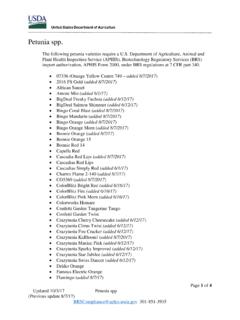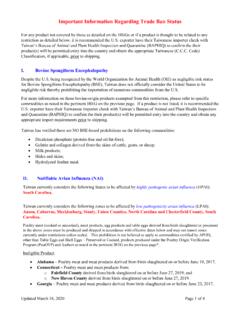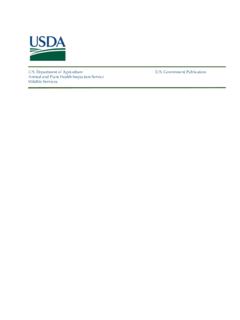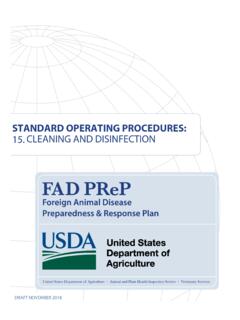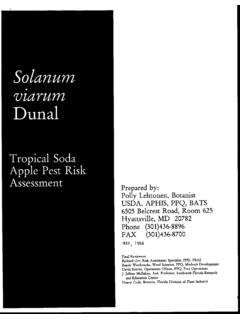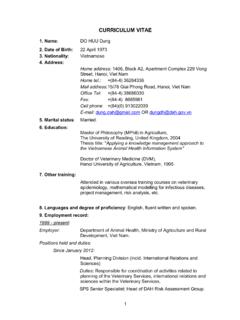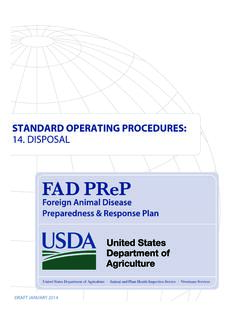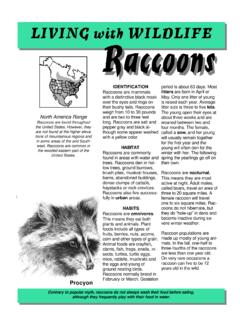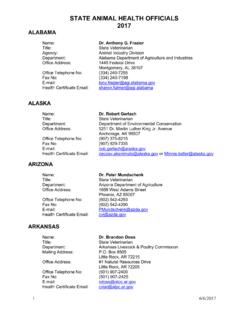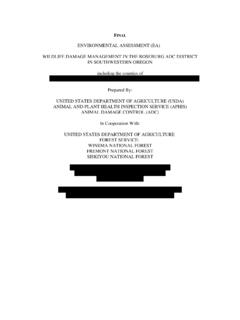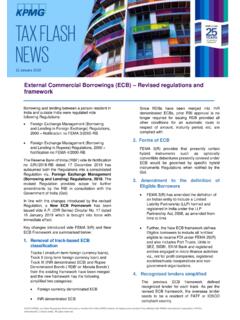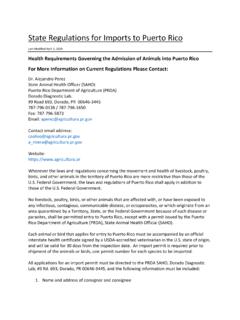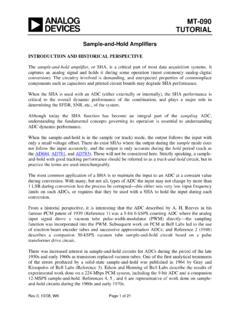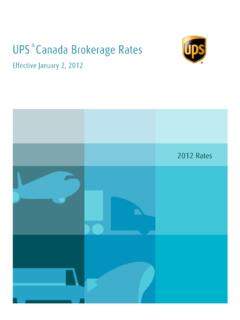Transcription of Cut Flowers and Greenery Import Manual - USDA
1 Cut Flowers and Greenery Import ManualSome processes, equipment, and materials described in this Manual may be patented. Inclusion in this Manual does not constitute permission for use from the patent owner. The use of any patented invention in the performance of the processes described in this Manual is solely the responsibility of the user. APHIS does not indemnify the user against liability for patent infringement and will not be liable to the user or to any third party for patent Department of Agriculture ( usda ) prohibits discrimination in all its programs and activities on the basis of race, color, national origin, age, disability, and where applicable, sex, marital status, familial status, parental status, religion, sexual orientation, genetic information, political beliefs, reprisal, or because all or part of any individual s income is derived from any public assistance program. (Not all prohibited bases apply to all programs). Persons with disabilities who require alternative means for communication of program information (Braille, large print, audiotape, etc.)
2 Should contact usda s TARGET Center at (202) 720-2600 (voice and TDD). To file a complaint of discrimination, write to usda , Director, Office of Civil Rights, 1400 Independence Avenue, SW., Washington, DC 20250-9410, or call (800) 795-3272 (voice) or (202) 720-6382 (TDD). usda is an equal opportunity provider and using pesticides, read and follow all label Edition Issued 201405/2012-50 Cut Flowers and GreeneryTOC-1 Cut Flowers and GreeneryContentsFiguresLOF-1Ta b l e sLOT-1 Introduction1-1 Procedures2-1 Reference3-1 Appendix AA-1 Appendix BB-1 GlossaryGlossary-1 IndexIndex-1 Contents TOC-2 Cut Flowers and Greenery 05/2012-5005/2012-50 Cut Flowers and GreeneryLOF-1 Cut Flowers and GreeneryFiguresFigure 2-1 Diagram of a General Inspection Table 2-4 Figures LOF-2 Cut Flowers and Greenery 05/2012-5004/2021-90 Cut Flowers and GreeneryLOT-1 Cut Flowers and GreeneryTablesTable 1-1 How to Use Decision Tables1-11 Table 1-2 Where To Report Problems with the Cut Flowers and Greenery Import Manual1-14 Table 2-1 Where to Collect Information Needed2-3 Table 2-2 Categories of Consignments2-8 Table 2-3 Screening for Restrictions Concerning CITES, ESA, Federal Noxious Weeds.
3 Or Parasitic Plants2-9 Table 2-4 Cut Articles Protected by CITES or ESA, or are FNW or Parasit-ic Plants2-9 Table 2-5 Cut Articles NOT Protected by CITES or ESA, or NOT Listed as a FNW, or Parasitic Plant2-10 Table 2-6 Cut Articles, Additional Considerations2-10 Table 2-7 Residue Cargo Handling2-11 Table 2-8 Requirements for Cut Flowers and Greenery from Specific Countries2-12 Table 2-9 Articles Moving Directly from or Moving Through the Netherlands2-13 Table 2-10 Guide to the Pest Risk Level of Cut Flowers2-14 Table 2-11 Determine the Inspectional Unit2-19 Table 2-12 Determine the Inspectional Unit For Shipments That Have Dif-ferent Genera2-19 Table 2-13 Determine the Sample Size of Each Inspectional Unit2-20 Table 2-14 Preparing Cut Flowers for Inspection2-22 Table 2-15 Action to Take When Inspecting Cut Flowers for Presence of Fruits2-22 Table 2-16 Quarantine Action to Take Based on Pest Findings2-23 Table 2-17 List of Flower and Country of Origin Combinations Eligible for Release2-24 Table 2-18 Determining Eligibility for Cut Flower Release2-24 Table 2-19 Decorative Branches or Stems from Host Plants of ALB or CLB2-29 Table 3-1 Acacia spp.
4 , Fabaceae3-4 Table 3-2 Acer spp. (maple), Aceraceae3-5 Table 3-3 Aegilops spp. (goatgrass) Poaceae3-6 Table 3-4 Aesculus spp. (buckeye, horse-chestnut), Hippocastanaceae3-6 Table 3-5 Ajania pacifica a monotypic genus (yellow splash) Asteraceae3-7 Table 3-6 Alnus spp. (alder), Betulaceae3-8 Table 3-7 Ananas spp. (pineapple) Bromeliaceae3-8 TablesLOT-2 Cut Flowers and Greenery 04/2021-90 Table 3-8 Arecaceae (alt. Palmae) (palms)3-9 Table 3-9 Capsicum spp. (pepper) Solanaceae3-10 Table 3-10 Castanea spp. (chestnut), Fagaceae3-11 Table 3-11 Chaenomeles spp. (flowering quince) Rosaceae3-11 Table 3-12 Chrysanthemum spp. (mum) Asteraceae3-12 Table 3-13 Coffea spp. (coffee) Rubiaceae3-12 Table 3-14 Cut Conifer Christmas Trees, Boughs, Wreaths, or Garlands from all Origins3-14 Table 3-15 Cut Conifer Christmas Trees, Boughs, Wreaths, or Garlands from Mexico3-15 Table 3-16 Cut Conifer Christmas Trees, Boughs, Wreaths, or Garlands from Canada3-16 Table 3-17 Cordyline spp.
5 Asparagaceae3-16 Table 3-18 Cordyline spp. Consignments Consisting of Solely Canes3-17 Table 3-19 Cordyline spp. Canes in Mixed Flower Bouquets3-18 Table 3-20 Cotoneaster spp., Rosaceae3-19 Table 3-21 Cycadaceae/Zamiaceae (cycads)3-20 Table 3-22 Cydonia spp. (flowering quince) Rosaceae3-21 Table 3-23 Cynara spp. (artichoke) Asteraceae3-21 Table 3-24 Dracaena spp. Asparagaceae3-22 Table 3-25 Dracaena spp. Canes only or Canes with Leaves from Costa Rica3-23 Table 3-26 Dracaena spp. Canes with or without Leaves, Shoots or Roots from Countries Other Than Costa Rica3-24 Table 3-27 Fraxinus spp. (ash), Oleaceae3-25 Table 3-28 Gossypium spp. (cotton) Malvaceae3-25 Table 3-29 Hibiscus spp. (giant mallow, rose mallow), Malvaceae3-26 Table 3-30 Hippophae spp. (sea buckthorn) Elaeagnaceae3-27 Table 3-31 Ilex spp. (holly) Aquifoliaceae3-28 Table 3-32 Leucanthemella spp. (high daisy, giant-daisy, max-chrysanthe-mum, Shasta daisy) Asteraceae3-29 Table 3-33 Loranthaceae (all genera of mistletoe)3-30 Table 3-34 Malus spp.
6 (apple), Rosaceae3-30 Table 3-35 Musa spp. (banana, dwarf banana, flowering banana, plantain)3-31 Table 3-36 Nepenthes spp. (pitcher plant) Nepenthaceae3-32 Table 3-37 Nipponanthemum spp. (nippon-daisy, nipon-chrysanthemum) Asteraceae3-33 Table 3-38 Oryza sativa (rice) Poaceae3-35 Table 3-39 Pelargonium spp. (scented geraniums) Geraniaceae3-36 Table 3-40 Phoenix spp. (date palm) Arecaceae3-37 Table 3-41 Physalis spp. (ground cherry, Chinese-lantern plant, Japanese-lantern) Solanaceae3-38 Table 3-42 Poaceae (all genera and species of grasses)3-39 Table 3-43 Polypodiophyta (Ferns)3-40 Table 3-44 Proteaceae (protea)3-41 Table 3-45 Prunus spp., Rosaceae3-43 Tables04/2021-90 Cut Flowers and GreeneryLOT-3 Table 3-46 Pyracantha spp. (firethorn), Rosacea3-43 Table 3-47 Pyrus spp. (pear) Rosaceae3-44 Table 3-48 Ricinus communis (castor, ricin) Euphorbiaceae3-44 Table 3-49 Rutaceae (all genera and species of the citrus subfamilies Au-rantioideae, Rutoideae, and Toddalioideae)3-45 Table 3-50 Salix spp.
7 (osier, willow), Salicaceae3-46 Table 3-51 Sarracenia spp. (pitcher plant) Sarraceniaceae3-47 Table 3-52 Sorghum bicolor (broomcorn) Poaceae3-48 Table 3-53 Triticum spp. (wheat and intergeneric crosses) Poaceae3-48 Table 3-54 Ulmus spp. (elm), Ulmaceae3-49 Table 3-55 Viburnum spp. (Guelder-rose, Japanese snowball, laurustine, snowball, summer snowflake) Caprifoliaceae3-50 Table 3-56 Viburnum spp. from Afghanistan, Austria, Belgium, Bulgaria, China, Croatia, Cyprus, Czech Republic, Democratic People s Republic of Korea, Denmark, Estonia, Finland, France, Germa-ny, Greece, Hungary, Indonesia, Italy, Japan, Latvia, Lithuania, Luxembourg, Malta, Poland, Portugal, Republic of Korea, Mad-agascar, Malaysia, Myanmar, Philippines, Romania, Slovakia, Slovenia, Spain, Sweden, Switzerland, Taiwan, or Vietnam3-50 Table 3-57 Viburnum spp. from Australia or New Caledonia3-51 Table 3-58 Viburnum spp. from Ireland or United Kingdom of Great Britain and Northern Ireland3-51 Table 3-59 Viburnum spp.
8 From the Netherlands3-52 Table 3-60 Viburnum spp. from New Zealand3-53 Table 3-61 Viburnum spp. from Countries Other Than Those Listed Above3-53 Table 3-62 Zea mays (corn and closely related plants) Poaceae3-54 Table A-1 How to Process Red-and White-Labeled Packages (PPQ Form 599)A-4 Table A-2 How to Process Green- and Yellow-Labeled (PPQ Form 505) PackagesA-7 Table A-3 Obtain a Copy of the Controlled Import Permit (PPQ Form 597)A-8 Table A-4 Processing Controlled Import PermitsA-9 TablesLOT-4 Cut Flowers and Greenery 04/2021-9004/2021-90 Cut Flowers and Greenery1-1 Chapter1 IntroductionContentsPurpose 1-2 Scope 1-2 Users 1-4 Related Documents 1-4 Convention on International Trade in Endangered Species of Wild Fauna and Flora 1-5 Endangered Species Act 1-5 Plant Protection Act 1-5 Code of Federal Regulations 1-6 Treatment Manual 1-10 Application 1-10 Conventions 1-10 Advisories 1-10 Boldface 1-10 Bullets 1-10 Change Bars 1-11 Chapters 1-11 Contents 1-11 Control Data 1-11 Decision Tables 1-11 Examples 1-11 Footnotes 1-12 Heading Levels 1-12 Hypertext Links to Figures, Headings.
9 And Tables 1-12 Indentions 1-12 Italics 1-12 Numbering Scheme 1-12 Transmittal Number 1-13 Using the Manual 1-13 Reporting Problems With or Suggestions for the Manual 1-13 Manual Updates 1-14 Ordering Additional Manuals and Revisions 1-14 IntroductionPurpose 1-2 Cut Flowers and Greenery 04/2021-90 PurposeThe Cut Flowers and Greenery Import Manual provides the background, procedures, and reference tables for regulating the fresh, cut portion of the plant when it is imported for decoration or ornamentation, and for protecting plants threatened with extinction due to trade in those plants or their articles from the countries of origin listed in this Manual are regulated because just one destructive pest might be enough to start a pest outbreak that can cause millions of dollars of damage to crops, trees, Flowers , or lawns. By their destructiveness, pests can increase the price and reduce the quality of food, lower property values, and ruin recreational areas.
10 The extinction of just one plant species does away with the aesthetic, ecological, educational, historical, recreational, commercial , and scientific value of our the Manual CoversThe Cut Flowers and Greenery Import Manual covers the fresh, cut portion of the plant including the cut flower and Greenery (as well as branches or stems and any fruits attached) for decoration or ornamentation, and are not intended for eating or Manual is divided into the following chapters: Introduction Procedures ReferenceThe Manual also includes appendixes, a Glossary, and an Introduction chapter contains basic information about the Manual . This chapter includes the Manual s purpose, scope, users, and application, a list of related documents providing the authority for the Manual s content, directions about how to use the Manual , and the conventions (unfamiliar or unique symbols and highlighting) appearing throughout the Procedures chapter provides the prerequisites and general directions for sampling, inspecting, determining pest risk, and regulating fresh, cut articles; and the protocol for the National Cut Flower Release Program (NCFRP).
